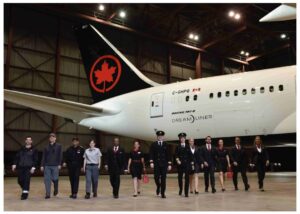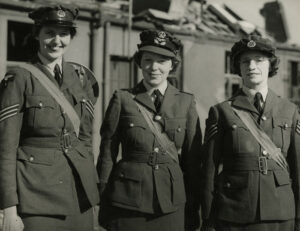The global workforce is evolving. Women are entering industries traditionally saturated by male workers; people are retiring later on in life and more opportunities for staff with special needs or disabilities are opening up across a wide range of industries. This means that workwear suppliers and their customers need to pay particular attention to improving inclusivity within their professional clothing ranges. Well-fitted, carefully considered uniforms can ensure that everyone feels valued, part of the team, are comfortable and safe.
As we stand on the eve of International Women’s Day, Bodi.Me’s CEO and co-founder, Lara Mazzoni, talks to several female leaders involved in uniform development, design and procurement, to get their views on how uniforms have, are and need to evolve to better support the growing female workforce.
In October 2023 the UK Office of National Statistics reported that the construction industry has seen a record increase in women workers. This is one example of an area traditionally dominated by men, now growing its female workforce, fast. The issue is that in many cases, workwear hasn’t been appropriately adapted for women and many women within these industries simply have to wear smaller men’s sizes, that do not always fit well. For companies like workwear suppliers, Alsico UK, who provide clothing across a range of industries, including construction, inclusivity has been a big factor in recent years. Alsico has found that women want options, so improving choice across their ranges has been a key focus. “We have expanded our female products in what was typically, our male-focused ranges, ensuring that women have the same choice as their male co-workers but in true female sizing that is suitable for the female form,” states Helen De Matos, Product Manager at Alsico. “We are currently also improving our plus size ranges to make sure that our products are adapted correctly for women and do not compromise comfort, nor appearance.”

Choice is also an important consideration at Air Canada. Nisha Muire, Manager, Uniform Program – Brand Management, at Air Canada states: “Inclusivity is extremely important to us. It is why our employees have access to all versions of the uniform within their scope of work and are not restricted to just the uniforms that would have been available to them based on gender assigned at birth.” However, Nisha also observes that fit remains a challenge, especially when employees are not able to try the uniforms on before ordering.

As a fit technology solutions specialist, Bodi.Me has found that fit can be a particularly problematic area for some women, especially with more formal or traditional garments where the designs may be more fitted. Bodi.Me’s CEO, Lara Mazzoni, says: “People tend to have a number in mind that they believe their size is, or should be, and they will order that size, whether it is the right fit for them or not. This is where accurate fit technology such as our Size-Me platform can help to save companies, their suppliers and of course the wearer a lot of time, and money, plus avoid discomfort. Our technology focuses on fit, rather than just the size. It allows the user to choose the best option for them from a range of recommendations. For example, a woman may know that some days she’ll need a slightly looser fit than others, so may select a garment with a more generous cut, or if she has the choice, an adjustable or stretchy garment, based on Size-Me’s fit recommendations.”
The changes a woman’s body goes through during key life stages, or indeed regularly due to the menstrual cycle, should be a key consideration when designing professional clothing. Sarah Wilsher is a Menopause & Menstrual Health awareness coach and trainer with a background in supply chain management and procurement within the uniform sector. She has worked with several uniform providers to advise on designing with menopause and menstrual health in mind. “The three main elements we look at are fit, fabrics and aesthetics, and how these elements can accommodate three key areas of consideration. These are: changing body image, size and weight distribution; fluctuations in body temperature; sensitive menopausal and menstrual symptoms such as stress incontinence and erratic periods,” states Sarah.
Simple but very achievable design inclusions can make all the difference to the female wearers and some of these measures that Sarah advises are: “We suggest that workwear providers include stretch fabrics or panels in the designs, offer adjustable or drawstring waists, add discreet ventilation such as eyelets and mesh panelling to allow airflow, offer layered options and use natural fabrics where possible.” Sarah also suggests practicalities such as using darker fabrics on trousers and skirts and the inclusion of a gusset in trouser designs, amongst other ideas.

Another enormously important consideration in workwear development is safety. There are still many women working in potentially hazardous situations, wearing protective clothing that may not fit them particularly well and even put them at risk. Natalie Wilson, Managing Director of Workwear Solutions who specialises in developing workwear with special safety and technical specification requirements states: “Inclusivity is everything, but encouraging, supporting and retaining a diverse workforce can only be achieved if the basic tools they need are suitable and fit for purpose.”

“We have developed vital military garments such as naval service combat uniforms in female and maternity fits, parade uniforms in modern female sizing and female fit sportswear. Many of these options either didn’t exist at all or were essentially small male items, not ideally suited to women” states Natalie. In another example, Workwear Solutions supported a major UK construction business to create bespoke female uniforms which also served as PPE, replacing the basic hi-viz yellow vests. “These vests are largely seen as ‘throw-away’ so not only do our designs offer a better and safer fit for women, but these solutions can also be much more sustainable as you change perceptions on the value of the uniforms,” Natalie points out.
Sarah Wilsher adds:” It’s frustrating to frequently hear that women in the workforce are often limited to standard male sizing for PPE. Poorly fitting PPE not only compromises the wearer’s safety but also violates health and safety regulations, ultimately defeating the purpose of protective clothing.”
Lara Mazzoni concludes: “Fit is so incredibly important for everyone, but it’s a particularly challenging area for women, especially as our bodies go through so many changes throughout life. What fits a size 10 woman in her 20s may not appropriately fit a size 10 woman in her 40s or 50s. This is why it is so important for companies to work with fit experts, such as Bodi.Me. Our garment fit solution uses high-quality data from more than 350,000 3D body scans and models, the latest machine learning and optimised algorithms to extrapolate a complete body profile from just a few simple, non-intrusive, measurements, delivering core recommendations with a high degree of accuracy. Getting the fit right from the very start is a win-win situation for everyone, from supplier, all the way through to the wearer.”

